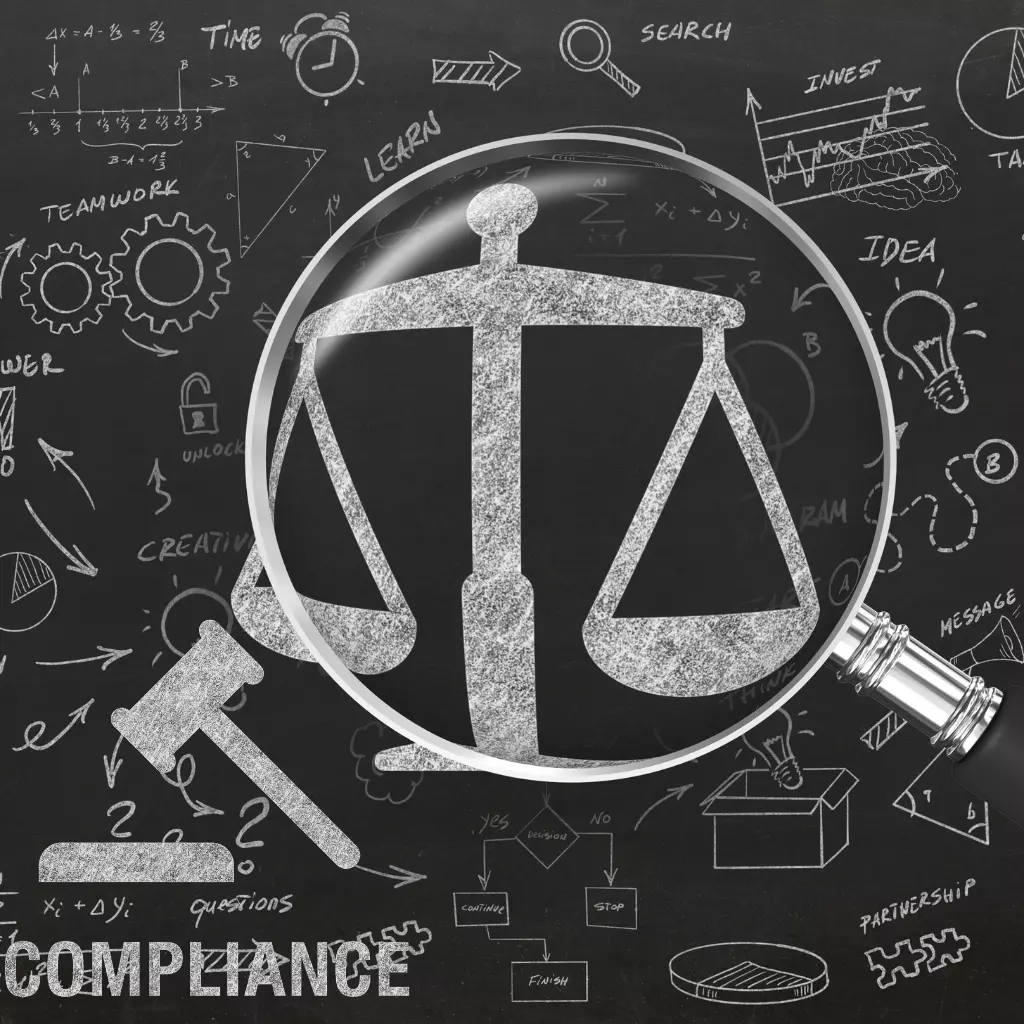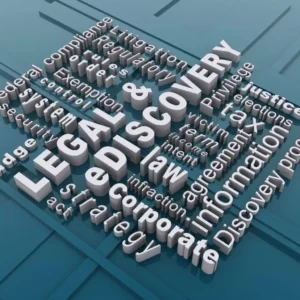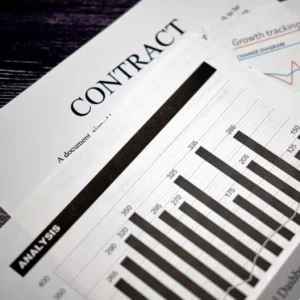
AI in Compliance Monitoring
Legal Standards and Predictive Oversight
Historically rooted in tradition, the legal landscape is experiencing a tectonic shift courtesy of artificial intelligence. AI in compliance monitoring is at the heart of this change, which promises to redefine the fabric of regulatory practices.
With the growing complexity of global legal standards and the pressing need for real-time updates, AI’s capabilities are both a luxury and a necessity.
This article explores the multifaceted applications of AI, from machine learning’s role in tracking regulatory changes to the power of predictive analytics in foreseeing potential breaches.
As the digital age demands more from legal professionals, AI emerges as an invaluable ally, ensuring compliance remains robust, proactive, and future-proof.
Table of Contents
Role of AI in Active Compliance Tracking
AI is essential for compliance monitoring in today’s rapidly evolving legal landscape. Active compliance tracking, once a tedious manual process, has been dramatically enhanced with the introduction of AI. Machine learning for regulatory updates stands out as a transformative approach. Instead of sifting through countless documents and regulations, firms can rely on algorithms that continually adapt and learn from new legal data.
Furthermore, AI-driven compliance reporting streamlines the documentation process and ensures accuracy, reducing the chance of human errors. And when it comes to understanding complex jargon in compliance documents, natural language processing plays a pivotal role. It efficiently decodes and categorizes compliance literature, ensuring that legal professionals are always informed and prepared.
The global nature of many businesses also requires them to meet a range of compliance standards across different countries. Here, AI tools for global compliance standards shine by navigating international compliance complexities seamlessly. Through predictive analytics in legal breaches, firms can preemptively identify potential risk areas, ensuring they remain ahead of any potential issues.
But with all these advancements, how are firms ensuring they protect their data while adhering to standards? What role does AI play in data privacy compliance in safeguarding sensitive information?
Keeping up with Changing Regulations
In the fast-paced world of legal standards, staying updated is crucial. Enter AI in compliance monitoring, a game-changer for legal professionals worldwide. With regulations continually evolving, the onus on firms to be in sync with every minor amendment can be overwhelming. That’s where machine learning for regulatory updates steps in. Advanced algorithms scan and analyze regulatory changes to keep firms compliant.
The dynamism of today’s legal environment also demands streamlined processes. Compliance reporting powered by AI ensures that any regulation updates are automatically incorporated into periodic reports. This adaptive reporting eliminates potential oversights and fosters confidence in stakeholders.
Simultaneously, understanding and assimilating these changing regulations becomes more straightforward with natural language processing. Legal professionals receive distilled insights by parsing and categorizing compliance documents without trawling through verbose regulatory texts.
For businesses operating internationally, the challenge multiplies. But AI tools for global compliance standards rise to the occasion, swiftly adapting to varied international mandates. This means a firm in New York can seamlessly align with regulations in Tokyo.
However, With all this automated tracking, how do firms prioritize which regulatory changes demand immediate attention? How are machine learning for risk assessment tools shaping this decision-making process?
Automating and Streamlining Reports
In the legal domain, accuracy and timely reporting are paramount. Yet, manually preparing these reports can be both time-consuming and error-prone. AI in compliance monitoring provides the much-needed respite. By harnessing the power of AI-driven compliance reporting, firms can automatically generate comprehensive reports, ensuring they remain up-to-date and precise.
Take, for instance, the complexity of natural language processing in compliance documents. Sifting through intricate legal verbiage can be daunting. However, with AI tools, parsing these documents becomes simpler. As a result, insights are extracted and integrated into reports with minimal human intervention.
Adapting to different compliance standards is essential for businesses that operate globally. Thanks to AI tools for international compliance standards, firms can effortlessly customize their reports to meet the unique regulatory requirements of various countries. Such automation ensures consistency and significantly reduces the reporting turnaround time.
It is essential to consider the use of predictive analytics in legal breaches. Firms can proactively highlight potential compliance risks by integrating these analytics into reporting mechanisms.
Yet, with this surge in automated reporting, a curious mind might ponder: How are these AI-driven reports ensuring transparency, and how do they compare with traditional, human-generated ones regarding reliability?
Predicting Potential Compliance Failures
While bound by rules, the legal world isn’t without its uncertainties. For firms, preventing a compliance misstep is always better than managing its aftermath. This is where the prowess of AI in compliance monitoring shines brightest. Through advanced algorithms and predictive analytics in legal breaches, firms can forecast potential pitfalls well in advance.
These predictive tools employ machine learning for risk assessment in the grand scheme. Analyzing patterns from vast troves of historical compliance data highlights areas that could potentially breach future regulations. Such a proactive approach ensures firms remain ahead, mitigating risks before they escalate.
But it’s not just about identifying risks. The sheer volume of compliance literature makes it challenging to discern which pieces are most pertinent. Leveraging natural language processing in compliance documents helps here. It aids in pinpointing regulations most relevant to a firm’s operations, further refining the risk predictions.
As businesses expand globally, keeping up with myriad local regulations becomes even more intricate. Fortunately, AI tools for global compliance standards provide insights into international risk factors, ensuring global operations remain fault-free.
With such proactive risk management in play, a thought arises: How are these predictions influencing firms’ strategic decisions, and what does it mean for their long-term sustainability?
Revolutionizing Audit Preparations and Processes
During audit seasons, one would usually think of disorganized file cabinets, sleepless nights, and overwhelming piles of paperwork. But with AI in compliance monitoring, this narrative is rapidly changing. The age-old process of audit preparations is getting a tech-infused facelift, all thanks to AI and machine learning advancements for regulatory updates.
Traditional methods often entailed manually cross-referencing documents, a process ripe for errors. Now, AI-enhanced audit processes automate this intricate task. By leveraging natural language processing in compliance documents, AI tools effortlessly sift through vast amounts of data, pinpointing discrepancies and ensuring alignment with current regulations.
Moreover, with the surge in international business ventures, audits are more comprehensive than local checks. AI tools for global compliance standards have come to the fore, offering a unified platform that accounts for varied international regulations. This ensures that multinational firms comply at home and in every corner of the globe.
But beyond just preparation, predictive analytics in legal breaches offer a forward-looking lens during audits. Firms can anticipate and address potential challenges head-on rather than being caught off-guard later.
Amidst all these advancements, a pertinent question lingers: How is the role of human auditors evolving in this AI-augmented landscape, and what skills will they need to thrive in this new era?
Decoding and Categorizing Compliance Literature
With its intricate vernacular and vast volume, legal literature can be a maze. But imagine a tool that deciphers and organizes this information at unprecedented speeds. That’s precisely where AI in compliance monitoring transforms how professionals interact with compliance documents.
Central to this transformation is applying natural language processing in compliance documents. This AI-driven technology deepens into legal texts, understanding context nuances and extracting the essence. The result? Regulatory documents, once overwhelming in their complexity, become concise insights ready for practical application.
Additionally, with machine learning for regulatory updates, these AI systems stay agile. They not only decode but also continually adapt, recognizing the evolving nature of legal standards. This means that whenever a new regulation surface or an existing one gets amended, these tools recalibrate, ensuring the categorized literature remains relevant.
The global nature of business today further compounds the complexity of compliance literature. Thankfully, AI tools for global compliance standards are adept at discerning variations across international regulations, ensuring companies have a holistic grasp of their compliance landscape.
But, while AI dramatically simplifies this domain, it raises a thought-provoking question: How will this influence the training of future legal professionals, and will the next generation lean more on AI interpretations than human expertise?
Navigating International Compliance Complexities
International business is vast and varied, like the myriad compliance regulations across countries. With globalization in full swing, companies face the intricate challenge of adhering to not just one but multiple legal landscapes. Enter AI in compliance monitoring, a beacon guiding firms through the labyrinth of international standards.
One of the standout marvels of this tech era is AI tools for global compliance standards. These sophisticated systems understand and collate rules from diverse jurisdictions, ensuring that businesses know the situation, irrespective of where they operate. Discover how our AI tools stay ahead of the curve with global insights and machine learning. With regular updates on international norms and regulations, our technology is always up-to-date and ready to help you succeed.
Then there’s the matter of deciphering vast international compliance literature. This is where natural language processing in compliance documents becomes invaluable. By effortlessly translating and categorizing foreign legal terminologies, it bridges the gap between local understanding and global operations.
Coupled with predictive analytics, firms can navigate and anticipate international compliance pitfalls.
Such advancements are undeniably groundbreaking, but they also evoke a pertinent query: As AI simplifies global compliance, how are businesses leveraging these insights for strategic international expansions?
Evaluating and Prioritizing Compliance Risks
In the vast sea of compliance, not all risks are created equal. Some can create ripples, while others can result in tsunamis of legal consequences. This distinction is vital, and AI in compliance monitoring plays a pivotal role in discerning between the two.
At the heart of this discernment lies the power of machine learning for risk assessment. These systems delve into historical data, identifying patterns and flagging potential high-risk areas. What once took legal teams weeks to deduce can now be achieved in mere minutes with AI-driven evaluations.
Yet, with the ever-evolving landscape of regulations, staying updated is crucial. These AI tools leverage machine learning for regulatory updates to ensure their risk assessments align with the latest compliance standards. This agility ensures that businesses are always aware of the most pressing risks.
Further enriching this risk assessment process is the application of natural language processing in compliance documents. This allows for a deeper understanding of complex regulatory verbiage, ensuring that the prioritized risks are genuinely the most pertinent.
Combine these with the foresight of predictive analytics in legal breaches, and businesses get a holistic picture of imminent threats.
But, with such advanced risk evaluations at their fingertips, one wonders: How are organizations transforming their operational strategies based on these AI-driven insights?
Ensuring Data Privacy in a Digital Age
The digital age has woven a tapestry of benefits, but it also presents a maze of challenges, with data privacy sitting right at the forefront. In an era where data breaches can damage reputations overnight, AI in compliance monitoring emerges as a sentinel, safeguarding sensitive information.
Protecting sensitive information is a top priority for businesses and individuals alike. That’s why AI-powered data privacy compliance systems have become crucial in safeguarding confidential data. These intelligent systems work tirelessly to identify potential weak spots and alert you in real-time so that you can stay one step ahead of any potential data breaches. With this powerful protection, you can rest easy knowing your information is safe and secure. This proactive approach ensures that data, the new gold, remains uncompromised.
Delving deeper into regulations, natural language processing in compliance documents aids in deciphering the complex web of global data protection laws. With GDPR and CCPA dictating stringent guidelines, understanding and adherence have never been more crucial.
Moreover, businesses leverage machine learning for regulatory updates to stay ahead of the curve. This ensures compliance mechanisms adapt simultaneously as data privacy norms evolve, offering unwavering protection against emerging threats.
Incorporating predictive analytics in legal breaches further empowers organizations, allowing them to forecast potential data privacy issues and take preemptive actions.
With such fortified defences in place, a thought-provoking query arises: As AI champions data protection, how is it reshaping how industries perceive and handle their digital assets?
Looking Ahead: AI's Evolving Role in Compliance
The role of AI in compliance monitoring has undoubtedly transformed the legal landscape. However, as with evolving technology, the horizon promises even more profound shifts and enhanced capabilities.
Machine learning for regulatory updates already ensures businesses know about sudden legal changes. The next leap? AI systems recognize differences and suggest organizational policy adaptations, ensuring seamless alignment with evolving regulations.
Natural language processing in compliance documents has already streamlined the cumbersome legal interpretation task. In the future, these tools will facilitate real-time translations of international laws, enabling immediate comprehension of global regulations without intermediaries.
AI-powered audit processes and compliance reporting will offer predictive insights into future scenarios, not just retrospective analysis. This forward-looking perspective will enable businesses to be steps ahead and always prepared.
Integrating predictive analytics in legal breaches will further bolster the proactive stance, potentially identifying breach patterns before they emerge.
As these advancements paint an exciting future, one can’t help but ponder: How will human expertise evolve and integrate with these cutting-edge tools?
Concluding Insights on AI's Impact on Compliance
The dawn of AI in compliance monitoring has ushered in a transformative era for the legal sector. No longer are businesses shackled by the limitations of manual tracking and interpretation. Instead, they’re empowered by AI’s prowess, seamlessly navigating the intricate tapestry of global regulations.
As businesses grapple with the shifting sands of international regulations, machine learning for regulatory updates emerges as a beacon. Gone are the days of missed updates and unexpected non-compliance penalties. Instead, businesses can anticipate changes, adapting with agility and precision.
Natural language processing in compliance documents has demystified the dense world of legal jargon. With AI tools effortlessly translating and categorizing this intricate literature, companies can operate with clarity and confidence on a global scale.
But AI’s influence isn’t just reactive; it’s profoundly proactive. Incorporating predictive analytics in legal breaches allows organizations to foresee potential pitfalls, ensuring they remain steps ahead. Likewise, AI-enhanced audit processes are revolutionizing traditional audit methodologies, adding a layer of predictive oversight.
Moreover, with data being the linchpin of the digital age, AI in data privacy compliance stands as a bulwark against potential breaches, safeguarding organizations’ most precious assets.
So, how does human expertise fit into this AI-dominated landscape? It’s simple: AI tools amplify human potential. While machines bring speed, accuracy, and foresight, human professionals provide context, judgment, and strategic oversight. Together, this synergy ensures that the future of AI in compliance management remains balanced, efficient, and forward-looking.
Related Articles
- AI in Pro Bono Case Selection: Maximizing Impact
- AI in Alternative Dispute Resolutions: The New Mediator
- AI in Courtroom Support: Revolutionizing Evidence Compilation
- AI-Driven IP Management: From Patents to Trademarks
- AI-Driven Document Categorization: Legal Filing Transformed
- AI in Compliance Monitoring: Legal Standards and Predictive Oversight
- AI-Driven Legal Chatbots: Future of Attorney-Client Interactions
- AI-Driven E-Discovery Platforms: Enhanced Efficiency and Precision
- AI-driven Legal Analytics: Transforming Decision-making and Litigation Strategies
- AI-Driven Legal Research: How Technology is Reshaping the Future of Law
- AI for Contract Analysis: Streamlining Processes and Predicting Success
- Other Articles on AI Usage in Legal
- Other Articles on AI usage in different industries
























